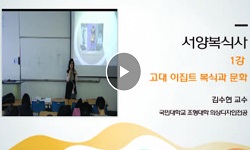While the film theories enrich the scope and depth of film analysis and interpretation, the theories borrowed from disciplines exterior to the cinema have also tended to slight the fact that filmmaking process inevitably involves materially and discur...
http://chineseinput.net/에서 pinyin(병음)방식으로 중국어를 변환할 수 있습니다.
변환된 중국어를 복사하여 사용하시면 됩니다.
- 中文 을 입력하시려면 zhongwen을 입력하시고 space를누르시면됩니다.
- 北京 을 입력하시려면 beijing을 입력하시고 space를 누르시면 됩니다.
부가정보
다국어 초록 (Multilingual Abstract)
Gunga Din instantiates the ways in which an imperialist master narrative propagates as the medium of representation changes. By examining the methods of operating at the shooting and observing imperialist discourse prevalent in the film industry, we can posit two, if related, possibilities: first, Stevens’ decision to have an “on location” film, where the visual overrides the textual and enlivens the historical-mythical memories long inscribed in the landscape text; second, genre conflict, where romance becomes unviable to grow on the larger genre template of masculine adventure. The top-down theories, though powerful and efficient in interpretation, may pre-empt what might otherwise become crucial to the understanding of a filmmaking. The transaction of ideology can be grasped not only through the analysis of film narratives, but also through the feasibility of inter-medial transformations. Gunga Din is construed interactively and inter- medially among genres and media, and the analysis of its filmmaking gives us some empirical purchase on just how imperialist discourse materializes in the making.
While the film theories enrich the scope and depth of film analysis and interpretation, the theories borrowed from disciplines exterior to the cinema have also tended to slight the fact that filmmaking process inevitably involves materially and discursively diverse mediums—story, script and screen. Or if acknowledged, the details of the material distinctions have been given short shrift. While capable of offering an insightful explanatory grip on a film’s underlying structures, implications and values, these extraneous theories often ignore this inter-medial transformation which filmmaking goes through.
Gunga Din instantiates the ways in which an imperialist master narrative propagates as the medium of representation changes. By examining the methods of operating at the shooting and observing imperialist discourse prevalent in the film industry, we can posit two, if related, possibilities: first, Stevens’ decision to have an “on location” film, where the visual overrides the textual and enlivens the historical-mythical memories long inscribed in the landscape text; second, genre conflict, where romance becomes unviable to grow on the larger genre template of masculine adventure. The top-down theories, though powerful and efficient in interpretation, may pre-empt what might otherwise become crucial to the understanding of a filmmaking. The transaction of ideology can be grasped not only through the analysis of film narratives, but also through the feasibility of inter-medial transformations. Gunga Din is construed interactively and inter- medially among genres and media, and the analysis of its filmmaking gives us some empirical purchase on just how imperialist discourse materializes in the making.
참고문헌 (Reference)
1 Richards, Jeffrey, "Visions of Yesterday" Routledge and Kegan Paul 1973
2 Hecht, Ben, "The Front Page" Covici-Friege 1928
3 Chatman, Seymour, "Story and Discourse" Cornell UP 1980
4 Singh, Shailendra, "Novels on the Indian Mutiny" Arnold-Heinemann 1980
5 Rimmon-Kenan, Shlomith, "Narrative Fiction: Contemporary Poetics" Routledge 1983
6 Rochelle, Reed, "George Stevens" Dialogue on Film 4.8 1-13, 1975
7 Metz, Christian, "Film Language: A Semiotics of the Cinema" Oxford UP 1974
8 Behlmer, Rudy, "America’s Favorite Movies" Frederick Ungar 1982
1 Richards, Jeffrey, "Visions of Yesterday" Routledge and Kegan Paul 1973
2 Hecht, Ben, "The Front Page" Covici-Friege 1928
3 Chatman, Seymour, "Story and Discourse" Cornell UP 1980
4 Singh, Shailendra, "Novels on the Indian Mutiny" Arnold-Heinemann 1980
5 Rimmon-Kenan, Shlomith, "Narrative Fiction: Contemporary Poetics" Routledge 1983
6 Rochelle, Reed, "George Stevens" Dialogue on Film 4.8 1-13, 1975
7 Metz, Christian, "Film Language: A Semiotics of the Cinema" Oxford UP 1974
8 Behlmer, Rudy, "America’s Favorite Movies" Frederick Ungar 1982
동일학술지(권/호) 다른 논문
-
- 문학과영상학회
- 배윤기
- 2010
- KCI등재
-
포스트헤게모니 시대의 문화정치: 쾌락, 권력관계 그리고 대중문화
- 문학과영상학회
- 조종흡
- 2010
- KCI등재
-
다큐멘터리의 극미학적 효과와 대중성 —<북극의 나누크>와 <워낭소리>를 중심으로
- 문학과영상학회
- 계운경
- 2010
- KCI등재
-
영상서사에 재현된 황진이 이야기의 두 가지 방식 —드라마 <황진이>와 영화 <황진이>의 비교를 중심으로
- 문학과영상학회
- 이명현
- 2010
- KCI등재
분석정보
인용정보 인용지수 설명보기
학술지 이력
| 연월일 | 이력구분 | 이력상세 | 등재구분 |
|---|---|---|---|
| 2026 | 평가예정 | 재인증평가 신청대상 (재인증) | |
| 2020-01-01 | 평가 | 등재학술지 유지 (재인증) |  |
| 2019-08-06 | 학회명변경 | 영문명 : Korean Association Of Literature And Film -> The Korean Association Of Literature and Film |  |
| 2017-01-01 | 평가 | 등재학술지 유지 (계속평가) |  |
| 2013-01-01 | 평가 | 등재학술지 유지 (등재유지) |  |
| 2010-01-01 | 평가 | 등재학술지 유지 (등재유지) |  |
| 2008-01-01 | 평가 | 등재학술지 유지 (등재유지) |  |
| 2005-01-01 | 평가 | 등재학술지 선정 (등재후보2차) |  |
| 2004-01-01 | 평가 | 등재후보 1차 PASS (등재후보1차) |  |
| 2003-01-01 | 평가 | 등재후보학술지 선정 (신규평가) |  |
학술지 인용정보
| 기준연도 | WOS-KCI 통합IF(2년) | KCIF(2년) | KCIF(3년) |
|---|---|---|---|
| 2016 | 0.17 | 0.17 | 0.2 |
| KCIF(4년) | KCIF(5년) | 중심성지수(3년) | 즉시성지수 |
| 0.23 | 0.26 | 0.491 | 0.04 |




 KISS
KISS



